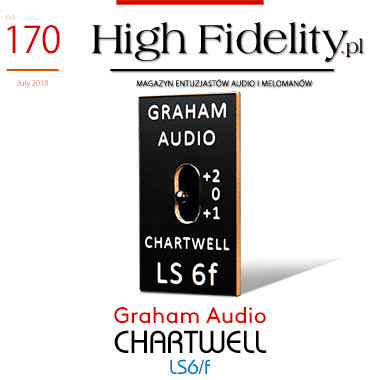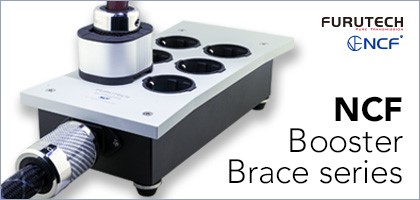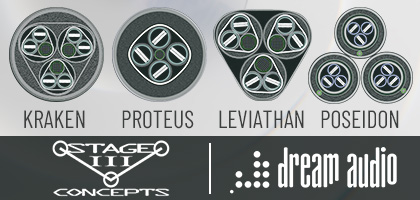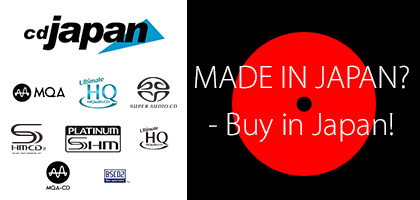No. 258 November 2025
- COVER REVIEW: BLADELIUS Oden II Class-A ⸜ integrated amplifier » SWEDEN
- INTERVIEW: "The Editors" series № 37: ANDREW SIMPSONS • Audiograde ⸜ editor-in-chief » UNITED KINGDOM
- TECHNIQUE: digital recorders: DENON PCM part 2 - DN-23R tape recorder || 1972-1974 » JAPAN
- REVIEW: ACOUSTIC REVIVE RTP-4EU Final ⸜ AC power strip » JAPAN
- REVIEW: AUDIO REVEAL Classic ⸜ integrated amplifier » POLAND
- REVIEW: FOUND SOUND DAVIO Davio Azure ⸜ digital-to-analogue converter » POLAND
- REVIEW: LAIV Harmony GaNM ⸜ power amplifier • monoblocks » SINGAPORE
- REVIEW: WARAN AUDIO Lava ⸜ AC power cable » POLAND
- MUSIC ⸜ Our albums series: ASTOR PIAZZOLA AND HIS TANGO QUINTET, Live in Lugano 1983, Ermitage/AudioNautes Recordings, Ultimate HiQualityCD


|

|
|
MQA + UHQCD: HI-RES COMPACT DISC, On may 23rd 2018, so exactly on my birthday (coincident?), CD Japan – the largest Japanese web-based store specializing in sales of physical music carriers – announced an introduction of a new kind of optic disc called Hi-Res CD. What is that? – Let me offer you a short quote from Universal Music Japan website: Hi-Res CD is a high-fidelity CD which combines MQA technology and UHQCD format (currently available exclusively in Japan only) together for the first time in the world. With this combination, Hi-Res CD realizes the high-resolution and compatibility at the same time. (with CD Players – ed.). 
Hi-Res CD titles released by Universal Music Japan that we know from Platinum SHM-CD and SHM-SACD versions We already know all the elements of this announcement, but for the first time they appear in one sentence: MQA, UHQCD, Hi-Res and Compact Disc. Still, we did not answer the question - what is it. In short, these are optical discs with basic parameters same as Compact Discs, but made in Ultimate HighQuality CD technology with a signal coded according to the Master Quality Authenticated algorithm . | Compact Disc (CD) Let's start with a CD:
The compact disc consists of three layers: a transparent polycarbonate (plastic), a metal reflecting layer and a transparent protective layer. On top, the disc can be covered with a varnish with information about the given title. These discs are read by the "red" laser, i.e. with a radius of 780 nm (more about CD format HERE). | Ultimate HighQuality CD (UHQCD) In 2009, in an article discussing the latest techniques of Japanese record labels, apart from SHM-CD and Blu-spec I also mentioned HQCD (HighQuality CD). HQCD was developed by the Japanese company Memory Tech. In this technique, instead of an aluminum layer, a silver alloy is used. What is even more important, however, is the modification related to the material in which pits and lands are stamped. Instead of polycarbonate, there are two layers used - the outer one is still polycarbonate, but the inner penetrating indentations is a photopolymer. 
In a classic CD, the polycarbonate fills the pits and when cooled it condences. The photopolymer, in turn, is a material that turns into a solid state when irradiated. The difference between them lies in the fact that polycarbonate fills the pits inaccurately, while the photopolymer almost perfectly . In measurements showing how the light of laser is reflected, the discs made in the HQCD technique perform much better than regular CDs. Last year, its upgraded version called UHQCD was introduced to the market. | Master Quality Authenticated (MQA) Master Quality Authenticated, is a technique belonging to the Meridian Audio and presented in 2014 by its founder, Mr. Bob Stuart. It was created from the need of streaming, that is, sending and listening in real time to high resolution files. Let's compare: a 24/192 file requires a bandwidth of 9.2 Mbps, and after folding it with MQA only 922 kbps. Music lovers no longer have to compromise; finally, we can hear exactly what the musicians have recorded. MQA is a clean, accurate and authentic path from the recording studio to the place where the listener enjoys music, whether it's a house or a car or when he's on the move. Meridian did not disclose the exact technical description, but we already know a lot, among others thanks to the "investigation" of the "Stereophile" magazine. We know that MQA is a two-sided, coding-decoding system . This means that the signal must first be encoded in the right way (on the studio or publisher's end) and then decoded (on the listener's). The system is compatible with all file players, i.e. computers and stationary players. 
The MQA file consists of two parts: a basic one in form of 24/48 ALAC, FLAC or WAV file, and an additional one. The latter is the second part of the signal and instructions for the decoder telling it how to unfold it. After decoding in an MQA-certified device, we get a signal with a higher sampling rate, in a form it was originally coded in by engineers, even 384 kHz. I think more experienced readers of "High Fidelity" already can see it: as far as the concept is concerned, it is almost identical to HDCD (High Definition Compatible Digital) . The difference is that the HDCD worked with the sampling rate of the CD, or 44.1 kHz, and it only allowed to increase the signal resolution from 16 to - theoretically - 20 bits. MQA is a LOSSY format . I write this word in capital letters, but also with hesitation. The data reduction is obvious - thanks to it, files with sampling frequencies of 2x, 4x and 8x of the basic frequency are coded and "folded" in a 24-bit "container" below the noise threshold. The additional part of the file is coded lossy - in the description of the process the company invokes origami as the origin of the idea. Regardless of this, MQA plays a different role - thanks to appropriate digital filters, similar to apodizing filters, Meridian promises to improve the quality of the signal by eliminating errors created during recording and A/D conversion. |

Jim Austin in a two-part article from January and February 2018, published in the "Stereophile" magazine, argues, however, that in this case one makes a mistake talking about "compression" and that "lossyness does not matter", adding: We already knew that MQA changed the sound. The goal of MQA is its improvement, and you can not improve anything without changing it MQA, however, arouses great controversy. Therefore, this is a good place to quote the opinion of Mark Waldrep, the owner of AIX Records, who has been recording high-resolution music for many years. Mark in chapter 18.4 of his book Music and Audio: A User Way To Better Sound, summing up his position, says: MQA filters can change the way the music sounds (due to the added high frequency delay) - the effect of MQA has not been proven yet and requires further testing (p. 697). Needless to say, he is not an advocate of this technique, and he's not alone. | Hi-Res CD At the beginning of 2018, MQA and Universal Music Group in the material titled MQA and Universal Music Group cooperate on advanced hi-res streaming on request announced cooperation and availability of UMG titles. The release of CDs with this kind of signal was only a matter of time. As we have already said, on May 23rd, the Universal Music Japan announced the launch one hundred titles with classical, jazz and popular music. What may seem like total nonsense, even if we agree that MQA changes the sound for the better. After all, this technique was developed to stream the signal over the Internet. With Blu-ray Audio and SACD formats available, launching another one seems idiotic. 
In the world of audio, however, not everything has a deep meaning, and to tell the truth, most of the moves don't make any sense at all. But, unlike Mr. Waldrep, who - also unlike me - does not appreciate either XRCDs or SACDs, I think that the only and final evaluation is listening by yourself - - if correctly prepared listening tests give repeatable results and these are positive, I assume that the given technology is valuable. This time the text you are reading is just an introduction to the issue, there will be time for listening tests. So let me just say why - potentially - Hi-Res CDs can be interesting. First of all - they are compatible with CD players . As far as I understand, these are NOT COMPACT DISCS, because the signal stored on them does not meet the requirements of the so-called Red Book standard. The situation with HDCDs was similar, and they could not be labeled with the Compact Disc logo. However, they can be treated as if they really were CDs, because for the average user there is no difference between them, except for the higher price of Hi-Res CDs. Their point, however, is not in their similarity to the CDs, but in the potential for "unfolding" the high definition signal . In order to decode the MQA signal one needs an appropriate decoder in a CD (SACD) Player or in an external D/A converter. It seems that the properly equipped DACs will be available first – actually some, as tested by us Mytek Liberty are already available. It will be even easier for companies whose devices are based on programmable DSP chips - in this case they just need to download the latest version of the software. Some of them are already ready, for example dCS. 
One of the players that can be modified using software is dCS Vivaldi One The first discs will not be available until June the 20th, so we do not know all the details yet. From the descriptions available at CD Japan it seems, however, that they are to be discs - as already mentioned - made in the UHQCD technique, additionally covered with a special turquoise paint, same as used for the most expensive currently produced discs, i.e. Platinum SHM-CD and SHM-SACD. Unfortunately, these will not be new remasters prepared specifically for this edition . Most of the material was remastered a few years ago in DSD for SHM-SACD releases. And it has its consequences. As we have said before, there are "various" MQAs. The company divides them into two categories: MQA Studio and MQA. We deal with the first one when a representative of a record company, musician or music producer who has power of attorney to approve the process is present during the material coding process. It requires comparative listening and active participation in them. MQA Studio turns on a blue diode in the decoding device. The green LED will light up when the file is encoded in the MQA, but without the participation of people associated with the recording or label. According to Bob Stuart, MQA director, signal resolution and sound quality are the same as in MQA Studio, but we are not sure about their origin. And, it's should be clear that Hi-Res CDs belong to the latter category - at least those that will be released on June 20th. I think, in the future, we should expect the "blue" versions as well, that will be sold at a higher price. | Summary One of the newer threads on Steve Hoffman's forum is: CD is dead? Here comes 100 MQA x UHQCD titles from Japan Universal Music (accessed: 29.05. 2018). The question is provocative, but the answer is trivial - yes, in the long run the Compact Disc format is dead, like SACD, Blu-ray (Audio) and all other physical formats, maybe accept for vinyl. "Dead", however, refers in this case to the mass market, not the specialized one. But something else is even more important: CD's death will not be caused by Hi-Res CD, but by streaming . Just not yet ... |
About Us |
We cooperate |
Patrons |
|
Our reviewers regularly contribute to “Enjoy the Music.com”, “Positive-Feedback.com”, “HiFiStatement.net” and “Hi-Fi Choice & Home Cinema. Edycja Polska” . "High Fidelity" is a monthly magazine dedicated to high quality sound. It has been published since May 1st, 2004. Up until October 2008, the magazine was called "High Fidelity OnLine", but since November 2008 it has been registered under the new title. "High Fidelity" is an online magazine, i.e. it is only published on the web. For the last few years it has been published both in Polish and in English. Thanks to our English section, the magazine has now a worldwide reach - statistics show that we have readers from almost every country in the world. Once a year, we prepare a printed edition of one of reviews published online. This unique, limited collector's edition is given to the visitors of the Audio Show in Warsaw, Poland, held in November of each year. For years, "High Fidelity" has been cooperating with other audio magazines, including “Enjoy the Music.com” and “Positive-Feedback.com” in the U.S. and “HiFiStatement.net” in Germany. Our reviews have also been published by “6moons.com”. You can contact any of our contributors by clicking his email address on our CONTACT page. |
 



|
   |
main page | archive | contact | kts
© 2009 HighFidelity, design by PikselStudio,
projektowanie stron www: Indecity










